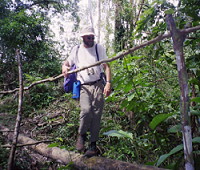
Photo. One of the participants in my tour group penetrating the dense jungle. © Travel Explorations.
In the Amazon part called Manu, the area is one of the most biologically diverse places on earth. Its home to over 1,000 species of birds 300 species of trees, and countless other life forms. It's also home to numerous indigenous Indian tribes. The most famous Indian inhabitants were the Incas. Their capital was in the Andes, but extended their empire into the cloud forest. With their large empire, the Incas had many contacts with the Indians in the jungle.
There are still Indians in the area, some are already used to visitors and others are more or less uncontacted. Not every tribe want visitors either. So how far could be go without crossing the line?
At its height, the Inca Empire spanned 3,000 miles (4,800 km) across South America. Inca territory was divided into quarters, with Cuzco as the centre, the city where the Inca Sun King had his residence.
The communication between cities was facilitated by "chaskis," couriers who ran between locations for providing messages and information.
I was in the Amazon jungle in July 2001. For me it was like entering a paradise. Everything looked so beautiful, and it reminded me of the description in the bible about the Garden of Eden. Of course it's tough to live here, both for the people and animals. Everyone struggle to survive in the hot and humid environment. It`s always the strongest right.
Advertise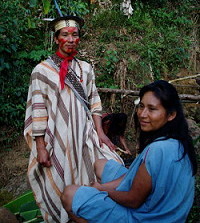 |
Peru for adventure travellers!
Join us on tours in Peru:
Machu Picchu, off beaten tracks in Amazon, exotic tribes and secret ancient wonders!
Contact us:
Coex Amazon
Lima, Peru
Telephone/Fax: + (511) 274-7010
E-mail: contact@coexamazon.com
Website: Coex Amazon
|
We took our way down the Madre de Dios River where we visited the remote Manu Wildlife Center (MWC). Here we explored the 30 miles of specially designed forest trails through the private rain forest reserve in search of 10 species of resident monkeys, including the Red Howler and Black Spider Monkey and many other species of flora and fauna.
We also took som nocturnal walks through the rain forest to search for the tapir, which is a 250 kilo beast, and the largest animal on land in South America.
|
It was interesting to get in touch with the locals to see how they lived.
Along the way, we visited an Indigenous Piro Indian Village and also at Boca Manu.
Photo. Indians in Manu, Amazon, in Peru.
© Travel Explorations.
|
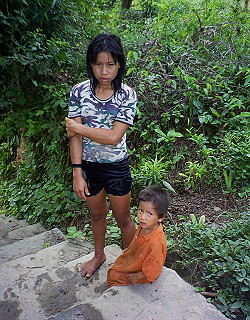 |
One place in the Manu area we were close to a tribe who where known to be hostile. So therefore we didn't venture to go further. I wouldn`t like to take the risk to approach them if there where a chance to get a bunch of arrows after me. We find it safer to steer the boat in another direction.
The Manu Biosphere is one of the most biodiverse areas in the world, containing 97 mammal species, 800 bird species, 60 reptile species, 78 amphibian species and over 3,000,000 invertebrates.
Mammals in the region include the bear, the deer, the puma, the pygmy marmoset, the red howler monkey, the squirrel monkey, the tapir, the collared peccary, the giant otter and the jaguar.
The Incas were inspired by many of the animals, escpecially the puma, which was populary used symbolic. According to the Incas, the world is made up of 3 parts: the future, the present and the past; the upper world, the physical world and the under world; the condor, the puma and the serpent.
|
Photo. A puma mask from Peru.
© Travel Explorations.
In the early 1400s the ninth Inca, Pachucutec, designed Cusco in the shape of a Puma, whose head and teeth are formed by the fortress of Saqsayhuaman. The puma is still very important for the Indians.
|
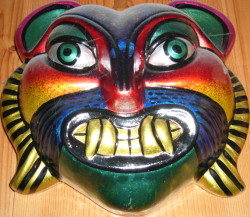 |
Reptiles that can be seen include the white caiman, the black caiman, the anaconda, the boa constrictor, the yellow-spotted sideneck turtle and the tortoise.
The caimans enjoy sun bathing in day time. We observed some of them on the shores of the rivers in the area. When we approached, they moved away and dived down to the cool water again. Some also rested in shallow water where you just could see the top of them. They looked like stones, but I can ensure you: they are pretty much alive. These rivers are not the places you just jump out in without checking carefully around - even if you are extreme hot.
The area is a real paradise for bird watchers. Here you find 800 varieties that include the harpy eagle, the jabirus, the roseate spoonbill, the Orinoco goose, the cock-of-the-rock, the macaw, the toucan, the king vulture, the tiger-heron and the hoatzin.
It was exciting paddling around oxbow lakes inhabitated by giant river otters, piranhas, anacondas, and black caimans, the largest of crocodiles in the Amazon. Some times when we observed something interesting, it was easy to forget to balance the canoe, but fornutately everything went fine.
|
Photo. My excellent and tough guide Ruby Huanca. © Travel Explorations.
It was definitely safer to sit in the boat than swimming in the river. We had to look up for caimans whole the time.
One late evening Ruby heard some strange sounds, which she suspected could be from a puma. So she ventured out in the dark searching for the predator (read more about on our website in an another article).
|
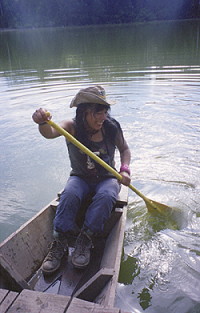 |
Look up for the caimans. They look look like stones in the water, but suddenly their reaction can come as "flash from a clear blue sky".
|
Photo. Down by one of the many the rivers in the Manu region, Amazon.
© Travel Explorations.
|
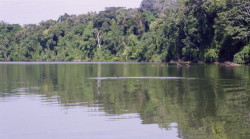 |
Today the life flourishes in Manu. The entire region of Manu covers a total size of 7200 square miles (1,881,200 hectares), and it's considered a Biosphere Reserve.
The Manu Biosphere Reserve covers three parts:
- The Manu National Park; a region protecting the natural flora and fauna;
- The Manu Reserved Zone, an area reserved for research and tourism; and
- The Manu Cultural Zone, a place used for human settlement.
Manu contains 13 different ecological zones ranging in altitude from 200m to 4,000m, meaning that it has an incredible variety of flora and fauna.
In the area there are plenty of opportunities for adventures. When you see at puma or caiman it will always be with mixed feelings. In one way it's very fascinating, but in another way it can make you very scared. You also need to stay on the right track so you don't encounter hostile Indians. In general people there are friendly as the rest of the Peruvians.
Stein Morten Lund, 2 April 2006
Additional information
Read more stories about the puma, Indians, ancient wonders and mysteries in Peru on our global travel guide www.TravelExplorations.com.

















